| Columns Retired Columns & Blogs |
Why does the photo of this Ultra look like it was clipped from a 1974 Stereo Warehouse ad? Right down to the black and white...even its slimline case....
The Ultra put out a very low 1.37V from the fixed-level outputs when decoding a full-scale, 1kHz sinewave. This is 3.3dB lower than the CD standard 2V output level, the only lower output we've experienced being the 730mV from the Sonographe SD-22 CD player reviewed by CG last month. The variable-level outputs, however, put out a whopping 4.18V with the level control all the way up. This makes a lot of sense: in a system with an active preamp, 1.37V is plenty of signal; for driving a power amplifier directly with the Ultra's variable output, the higher output voltage is essential.
The level attenuator's channel balance was measured at six settings between 500mV and 4V. At 500mV, the right channel was 0.46dB lower in level than the left channel. This moderate imbalance decreased to virtually no error (0.05dB) at 1V output (a typical output level) and maintained a comparable tracking accuracy (less than 0.08dB) up to 4V output. From the fixed outputs, the right channel was 0.12dB higher than the left channel.
Frequency response, shown in fig.1, was flat over most of the band, but with a 0.45dB rolloff at 20kHz. De-emphasis error (fig.2) was negligible and consistent between channels, with a 0.12dB negative error at 20kHz.
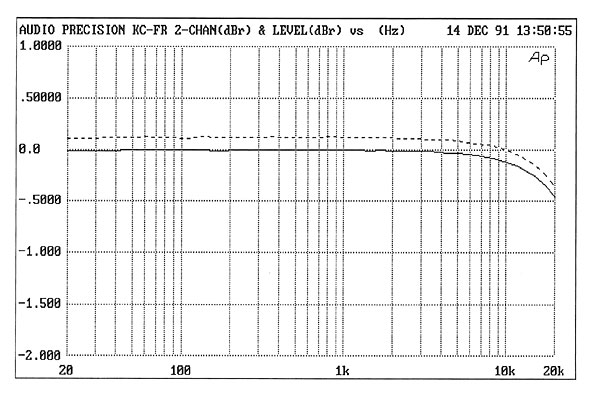
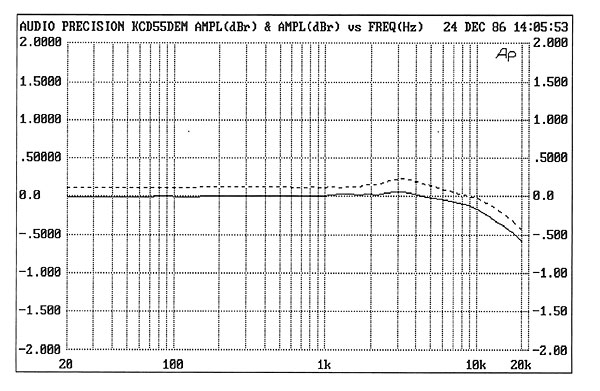
Looking at a spectral analysis of the Ultra's output when decoding a dithered –90dB, 1kHz sinewave (fig.3) revealed good low-level linearity, with excellent matching between channels. There is, however, a large amount of power-supply–related noise at 60Hz, 120Hz, and 240Hz. The 120Hz component is equal in amplitude to the test signal. When I first saw this, I considered it a measurement artifact and not intrinsic to the Ultra. I tried every possible permutation of grounding hookups between the processor and the Audio Precision System One to remove the hum, but was unsuccessful; this was the best-looking trace obtainable. When the Ultra's chassis wasn't grounded at all to the System One, some energy appeared in this curve at 4.2kHz at a level of about –100dB. This suggests users should pay attention to the Ultra's grounding arrangement in their systems. After performing this measurement, I put my ear right up to the loudspeaker and turned the Ultra's level control all the way up. Not a trace of hum was heard, casting doubt on the existence of the noise seen in fig.3.
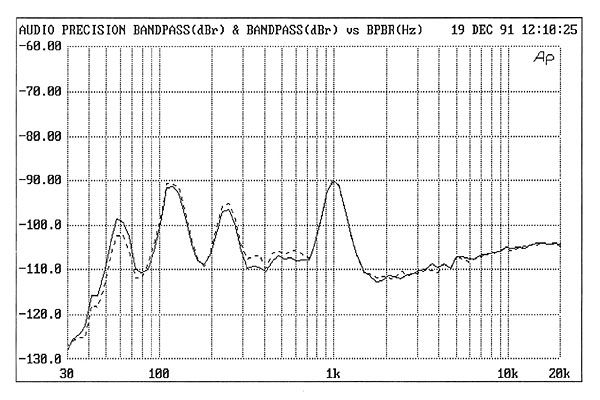
Linearity, shown in fig.4, was excellent—as I've come to expect from UltraAnalog DACs. At –90dB, the error was +0.08dB (left channel) and +0.16dB (right channel)—virtually perfect. At –100, there was a 0.68dB positive error (left) and 0.96dB (right). This "error" is more likely noise at this extremely low signal level. This is about as good as D/A converters get.
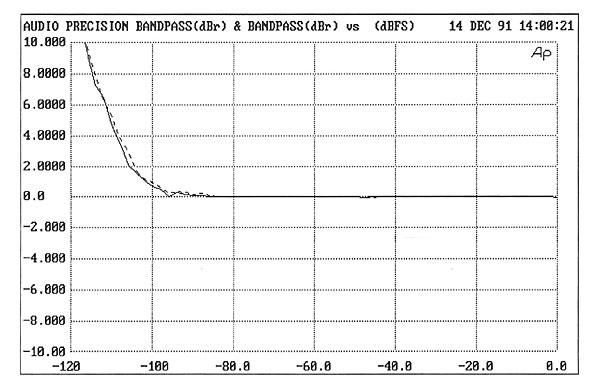
Interchannel crosstalk (fig.5) was fairly good, measuring 90dB at 100Hz, decreasing to 76dB at 10kHz. Capturing a –90dB, undithered 1kHz sinewave produced the plot of fig.6. The sinewave looks a little unusual in that the negative-going portion of the waveform looks different from the positive. In addition, the power-supply noise seen in fig.3 overlays the 1kHz sinewave. Notice how the tops of the waveforms don't line up horizontally, indicative of a low-frequency component in the signal.
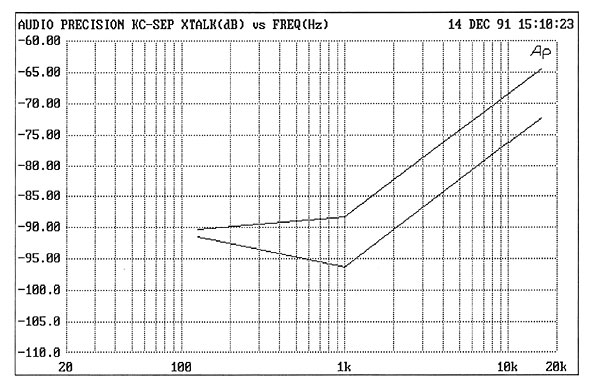
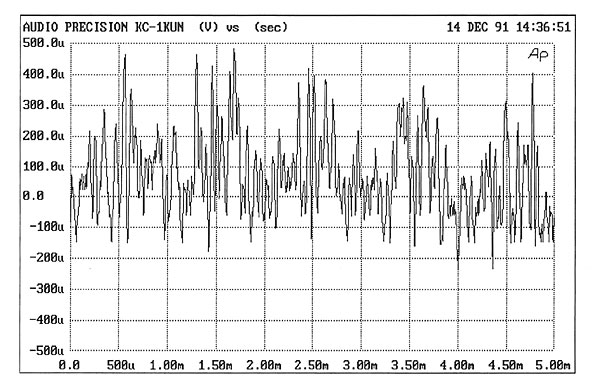
The Ultra had a low level of intermodulation products when decoding a combination of 19kHz and 20kHz at full scale (fig.7). The 1kHz product is well suppressed, and the 24.1kHz product (44.1kHz sampling frequency minus the 20kHz signal) is absent. The shape of a full-scale, 1kHz squarewave (fig.8) is typical of linear-phase digital filter chips like the Sony CDX1144B.
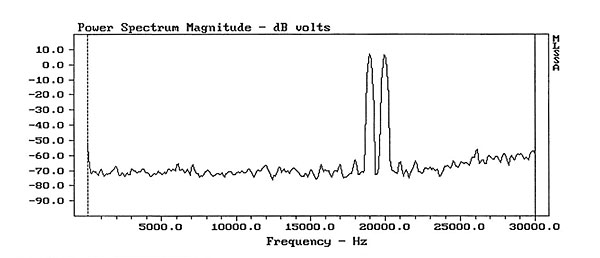
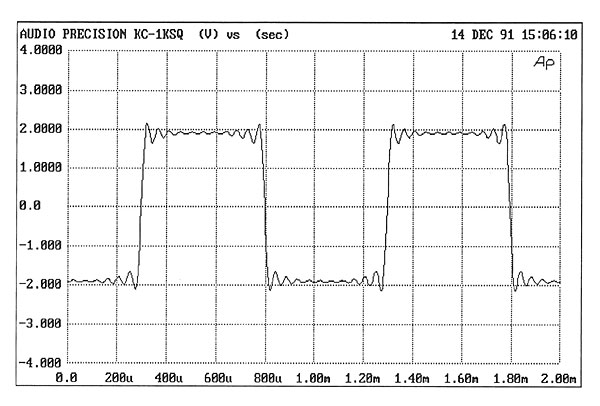
Output impedance from the fixed outputs was a fairly low 245 ohms across the band. The variable outputs had an extraordinarily low output impedance of 1.2 ohms at 20Hz, increasing to 1.6 ohms at 20kHz (measured with the level control full up). As expected, this value increased with the level control in a typical position (750mV output), to 313 ohms across the band. The Ultra should thus have no trouble driving any power amplifier or cable.
The Ultra doesn't invert absolute polarity unless the front-panel switch is in the "invert" position. I was a little disturbed by the fairly high level of DC at the outputs: 86mV from the fixed outputs. No DC was measured at the variable outputs, suggesting that a coupling capacitor is part of the variable-level output circuit. I surmise that Kinergetics designed the Ultra with the assumption that the fixed outputs would be used with a preamp that would prevent DC from reaching the power amplifiers, but the variable outputs would have no such protection.
A new digital processor measurement was described in a short feature following the Mark Levinson No.30 review in last month's issue. Basically, I drive the processor with data representing a low-frequency (41Hz) sinewave at levels ranging from –60dB to –100dB, remove the sinewave from the resultant analog signal with a steep high-pass filter, then analyze the residual noise across the audio band. Ideally, the noise floor measured in this manner should be a straight line sloping up from left to right at all levels of the 41Hz sinewave. In practice, the noise changes its level in the presence of signal (this is called "noise modulation"), meaning that the traces taken at different levels will no longer overlay. The greater the disparity in noise floors, the worse the sound, is the supposition behind this measurement technique.
The Ultra's noise modulation results are shown in fig.9. The KCD-55 Ultra's noise floor is considerably higher than the No.30's (fig.6 at the article. It has, however, a close grouping of the curves, meaning that the noise floor will not change in level or tonal quality along with the music.
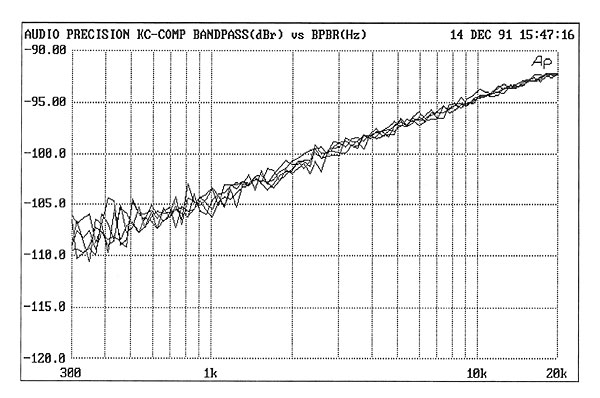
Overall, the Ultra measured well except for the power-supply–related noise seen in the spectral analysis. Although I repeated the measurement at two different locations and with many grounding arrangements (with the same results), I still suspect that the noise could be a measurement artifact.—Robert Harley

Why does the photo of this Ultra look like it was clipped from a 1974 Stereo Warehouse ad? Right down to the black and white...even its slimline case....